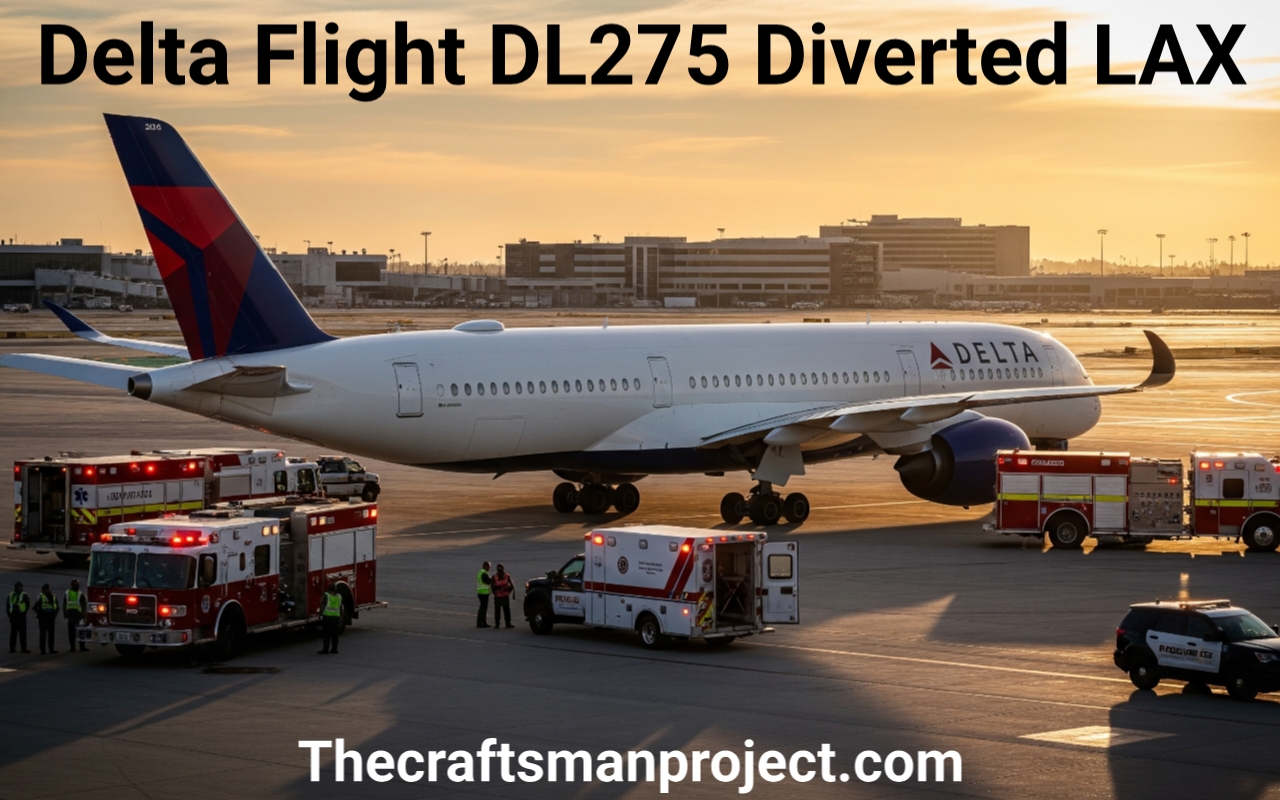Introduction
Aviation is one of the safest modes of transportation in the world, owing much of its reliability to the meticulous planning and careful attention to detail by airlines, air traffic control, and aircraft manufacturers. However, even with the extensive safety systems and protocols in place, unexpected events can still arise mid-flight, forcing airlines to make tough decisions. One such event occurred on Delta Airlines Flight DL275, a long-haul flight from Detroit Metropolitan Airport (DTW) to Tokyo Haneda Airport (HND), when the aircraft was unexpectedly diverted to Los Angeles International Airport (LAX).
The diversion raised several questions regarding the cause, impact, and lessons learned. This article delves deep into the incident, shedding light on why Delta Flight DL275 was diverted to LAX, the sequence of events that unfolded, and what can be learned from this experience for future flights.
Flight DL275: The Initial Journey from Detroit to Tokyo
Delta Airlines Flight DL275, a transpacific flight, was scheduled to depart Detroit Metropolitan Airport (DTW) and head to Tokyo Haneda Airport (HND), one of Japan’s busiest and most important international airports. The journey was expected to cover approximately 6,800 miles over a period of roughly 12 hours and 15 minutes. The aircraft assigned to the flight was an Airbus A350-900, a state-of-the-art, fuel-efficient, and long-range aircraft capable of carrying over 300 passengers and delivering a smooth flying experience even on extended international flights.
The flight was originally delayed by a few hours due to late inbound aircraft from Amsterdam, but after clearing customs and securing all the necessary paperwork, the aircraft took off from Detroit at approximately 3:53 PM local time. Everything seemed normal initially, with the passengers and crew preparing for what was expected to be a routine long-haul journey. However, as the plane reached its cruising altitude of 38,000 feet and the crew settled into the rhythm of the flight, something unexpected was brewing in the background that would change the course of the entire trip.
The Root Cause: Engine Anti-Ice System Malfunction
About six hours into the flight, while the aircraft was cruising over the North Pacific Ocean, approximately 620 nautical miles southwest of Anchorage, Alaska, the flight crew received an alert indicating a potential malfunction with one of the Rolls-Royce Trent XWB engines. Specifically, the issue was related to the engine’s anti-ice system—a critical component that helps prevent ice from accumulating on essential engine parts during high-altitude flights.
Flying at cruising altitude in cold environments means that ice can build up on various components of an aircraft, including the engine’s air intakes, which can affect its performance. The anti-ice system is designed to prevent such accumulations by utilizing heated air to keep engine components clear of ice. If this system malfunctions, it poses a significant risk, as the buildup of ice could lead to engine performance issues or, in the worst-case scenario, an engine failure. The situation became more critical as the aircraft was still hours away from its destination and could not continue its flight safely without a functioning anti-ice system.
The flight crew immediately contacted Delta’s operations control center to report the issue and began to assess their options. In collaboration with ground-based engineers and specialists, it was determined that the malfunction could pose a serious risk to engine performance and that continuing on the intended flight path would not be advisable. After considering the available options, the decision was made to divert the flight to the nearest suitable airport equipped to handle such a situation.
The Decision: Diverting to Los Angeles (LAX)
The decision to divert Delta Flight DL275 to Los Angeles International Airport (LAX) was not taken lightly. When a plane is forced to divert, it must factor in several critical elements, such as the nearest available airport, the condition of the aircraft, and the safety of the passengers and crew. In this case, LAX was the most practical choice due to its proximity to the flight’s current location, its extensive facilities, and its role as a major hub for Delta Airlines. Additionally, LAX has the required infrastructure for handling emergencies, including firefighting equipment and emergency medical services, which provided further assurance in this critical situation.
The flight crew informed the passengers about the situation, assuring them that safety was their top priority. Although the passengers were understandably concerned, the professionalism of the crew helped calm any potential panic. At this stage, the flight was still a few hours away from LAX, and the crew began preparing for a potential emergency landing. They continued to communicate regularly with Delta’s operations center and air traffic control, ensuring that all necessary arrangements were made for the diversion.
The crew followed standard protocols for in-flight diversions, which included careful planning for fuel management, the monitoring of the engine’s performance, and preparation for a smooth descent into LAX. The diversion meant that the passengers would experience significant delays and potential inconvenience, but this was a far better outcome than continuing the flight without resolving the malfunction.
The Emergency Landing: A Safe Arrival at LAX
As the aircraft made its approach to LAX, the situation remained tense but controlled. Emergency response vehicles were positioned along the runway in case anything went wrong during the landing. The aircraft was cleared for landing, and the crew carefully executed the descent, ensuring that the aircraft was stable and the anti-ice system issue was contained.
Upon arrival at LAX, Delta Flight DL275 touched down safely without incident, and the passengers were able to disembark. While the landing itself went smoothly, the real work began once the aircraft was on the ground. The aircraft underwent a thorough inspection by Delta’s maintenance team, which confirmed that the anti-ice system malfunction was the primary cause of the diversion. The aircraft was immediately taken out of service for maintenance, and the required parts were replaced, ensuring the plane was safe for future flights.
From a passenger perspective, the diversion was both a relief and an inconvenience. The passengers were provided with support, including alternative flight arrangements, meals, and accommodations where necessary. Despite the distress caused by the delay, many passengers were appreciative of how the situation was handled by the flight crew and the airline.
The Financial Impact: A Significant Cost to Delta Airlines
While the diversion was the right decision to ensure passenger safety, it did come with significant financial implications for Delta Airlines. The total cost of the diversion has been estimated to be around $2.3 million. This total includes several factors such as:
- Fuel: The aircraft had to burn more fuel than originally planned, as it was diverted off course and had to make additional maneuvers during the emergency descent. This added a considerable cost to the operation.
- Landing Fees: As with any emergency landing, Delta incurred fees for the use of LAX’s facilities, which are typically higher for unscheduled landings.
- Passenger Rebooking and Accommodation: Given the delay, many passengers had to be rebooked on connecting flights or provided with hotel accommodations overnight. This added to the operational costs for Delta.
- Maintenance and Inspection: After the landing, the aircraft underwent a detailed inspection, and maintenance work was required to address the anti-ice system malfunction. This further contributed to the cost of the diversion.
- Compensation: Passengers were offered compensation for the disruption, which further increased the financial impact.
Although these costs were significant, Delta Airlines made the right decision by prioritizing safety above all else. The financial burden was a necessary consequence of preventing any further issues during the flight.
The Passenger Experience: Anxiety and Relief
The experience of being on a flight that gets diverted is undoubtedly stressful for passengers. On Delta Flight DL275, passengers were initially unaware of the severity of the issue. As the aircraft began its descent towards LAX, the crew informed them of the diversion, explaining that it was due to a technical malfunction. This sudden change in plans led to a mixture of emotions among the passengers—uncertainty, anxiety, but also relief that the crew was taking appropriate action to ensure everyone’s safety.
Many passengers noted that seeing emergency vehicles lining the runway as the aircraft landed added an extra layer of anxiety to the situation. However, once the plane touched down and passengers were informed that the situation was under control, the mood shifted to one of relief. Passengers shared their experiences online, expressing their gratitude to the flight crew and Delta Airlines for handling the emergency with professionalism and transparency.
Despite the inconvenience of the diversion, the overall sentiment among passengers was positive, as they acknowledged that their safety had been the airline’s top priority. The professionalism of the flight crew and the smooth handling of the emergency landing helped mitigate some of the frustration caused by the delay.
Predictive Maintenance: The Future of Aviation Safety
The incident involving Delta Flight DL275 underscores the growing importance of predictive maintenance systems in modern aviation. Predictive maintenance involves using advanced data analytics and artificial intelligence (AI) to monitor an aircraft’s components in real-time. This technology can detect early signs of potential failure and predict when a part is likely to malfunction, allowing airlines to address issues before they result in significant problems.
In the case of Delta Flight DL275, the malfunction in the engine’s anti-ice system was a critical issue that led to the diversion. However, if predictive maintenance systems had been in place to identify the issue earlier, the malfunction might have been detected before the flight even departed. This would have allowed the airline to address the problem proactively, potentially preventing the need for an emergency diversion altogether.
As technology continues to evolve, predictive maintenance will become more common in the aviation industry. Airlines will continue to invest in systems that allow for better monitoring and early detection of potential issues, ensuring that flights are safer and more reliable for passengers.
Lessons Learned: Improving Aviation Safety Protocols
The diversion of Delta Flight DL275 to LAX serves as an important lesson for the aviation industry. While the event itself was a rare occurrence, it highlights the need for continuous improvement in aviation safety protocols and response systems. The professionalism and quick decision-making of the flight crew, combined with the readiness of LAX’s emergency response teams, ensured that the situation was handled effectively.
One of the key lessons from this incident is the importance of integrating new technologies and safety measures into aviation practices. The use of predictive maintenance systems, enhanced real-time monitoring, and improved communication channels between crews and operations control can all contribute to reducing the likelihood of similar incidents in the future.
Conclusion: A Focus on Safety
In the end, Delta Flight DL275’s diversion to LAX was a case where the airline’s commitment to safety and professionalism was evident. While the incident caused a significant financial impact, it was a reminder of the critical importance of prioritizing passenger safety over all else. As the aviation industry continues to evolve, this event underscores the need for continuous improvements in technology, maintenance, and response protocols to ensure that air travel remains as safe as possible.
By learning from this experience and implementing more proactive safety measures, airlines can better equip themselves to handle unexpected situations and keep passengers safe in the air.

